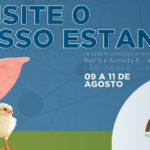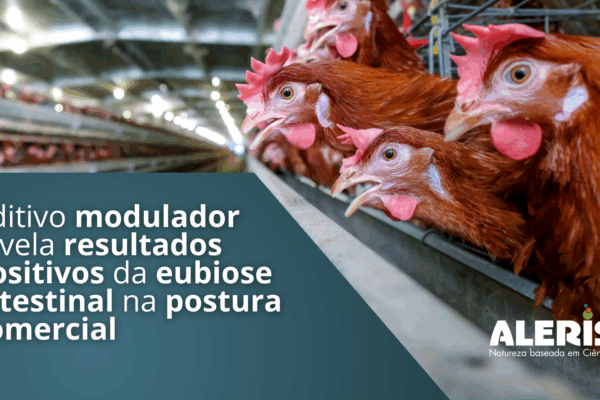Aquaculture: the use of Additives in Production
Authors:
Alexandre Carvalho Wakatsuki – Zootechnician – Technical Consultant in Aquaculture – ZooPeixes Consultoria
Vanessa Olszewski – Veterinary Doctor – MSc. Monogastric Nutrition UFPR – Technical Coordinator Aleris Nutrition
The intensification of fish production in Brazil is an expanding activity and shows the need to seek efficiency in its processes and procedures with regard to environment, species, food and health, in order to make an activity sustainable and economically viable.
The adoption of technology is essential for these objectives to be achieved, always having as a reference that the basis of production are: management, genetics and nutrition of the cultivated species.
When we think about nutrition for fish, several studies are carried out to know and understand how to apply the best methodology in production, to obtain maximum gains in zootechnical and economic results. To do this, it is necessary to find and define nutritional requirements for each species of fish.
Within this study, in the popular first question regarding parameter assigned to fish feed is the value of protein, and within this context we have to understand and direct all attention to the levels of essential amino acids that will make up the diet with the aim of obtaining the best result in the growth of the species.
Today much is said about crude protein and/or total amino acids, however, the best way to qualify and quantify a feed is through the digestible protein, or rather, digestible amino acids in the formulation.
Regarding proteins, amino acids can be highlighted. Knowledge of its digestibility in the ingredients used is essential to consider a product with maximum efficiency that will bring both environmental benefits, emitting less residue of substances via excreta, and promoting better performance in the animal, and it is also essential that the assessment of cost versus benefit is technically viable.
For protein composition, the sources available for use in the fish feed diet are: soybean meal, peanut meal, fish meal, chicken offal meal, hydrolyzed feather meal, meat and bone meal, blood, hemoglobin, corn gluten, corn DDG and others.
Linked to this condition, it is essential to know the raw materials and their suppliers so that the product follows as established in the nutritional matrix of the formulation program. Within the same type of ingredient we can have different prices and different qualities, such as meat and bone meal.
O second parameter What we must observe is the level of ethereal extract or fat, which is an excellent source of energy for fish and which, together with carbohydrates in the diet, makes up the energy part.
You carbohydrates they contribute to the performance of animals in their productive activities and as some of these ingredients contain starch in their composition, they also help in the feed production process (extrusion).
With this attribution, we can highlight a wide range of inputs, such as: corn, sorghum, millet, wheat bran, rice grits, rice bran that help to make up the energy part of the ration.
There is one optimal energy:protein ratio in the formula and so that there is no imbalance in the consumption and absorption of nutrients and impair the performance or accumulation of fat in the animal, attention must be paid when producing the feed so that the amount of fat and carbohydrates does not cause an imbalance in the energy relationship: ideal protein.
Some protein ingredients contain a good amount of fat that helps in the composition along with the addition of soybean oil, fish oil, chicken oil, etc. Maintaining this balance, the fish will have good muscle formation and/or good fillet yield, with low accumulation of body fat.
The addition of appropriate amounts of vitamins and minerals -vitamin-mineral premix- in diets complements the nutritional requirements of each species and can contribute to the best development condition of the fish, by optimizing nutrient absorption and contributing to the animal's physiological processes.
Other parameters should also be mentioned as crude fiber, which is characterized by the amount of fiber that makes up the formula. As the majority of fish species produced are not herbivorous, it is essential to pay attention to their inclusion in feed so that a high amount of fiber may not interfere with digestibility. It is important to always understand the capacity of the species that will be cultivated in order to maintain the optimum level for optimal movement and intestinal health.
A mineral matter (ash) It is what is left over in the process and ends up not being used by the body, and therefore the lower the value of this item in the laboratory report, the better the quality of the product.
Already the moisture is another item always observed on the labels and for good product stability in storage it is necessary that it does not exceed 10-12% of humidity, to avoid loss of feed due to mold and mildew in the field.
There is still a need to better understand the raw materials and the suppliers' products in more detail to have parameterized the main choice indices in the food strategy.
When we have accurate data, it becomes clearer which path or strategies to follow. An example of this is that the additive will reach its maximum economic potential when we know how to use it to enhance nutritional gains.
Additives must be used with knowledge and closely based on the food and/or environmental strategy to optimize production, in addition to following the regulations of the Ministry of Agriculture, Livestock and Supply (MAPA) under normative instruction 13/04 (amended by normative instruction no. ◦ 44/15). It is also important to demand from additive suppliers clear information about the product and the analyzes necessary to guarantee its effectiveness.
Within this context, our main challenge is to understand what problem the animal will be exposed to, taking into account the cultivation phase, the production system and the time of year. Having this knowledge will help you to include the correct additive and in the indicated inclusion to minimize the challenge or problem caused by sanitary or even management factors.
There are several types of additives, as illustrated in Table 1, each with its own specificity and therefore it is important to understand and be clear about the best strategy for applying them in the field.
Table 1. Additives used in animal diets.
|
Type |
Characteristics |
Functions |
|
Technological |
Any substance added to the diet for technological purposes, such as preservatives, antioxidants, adsorbents, among others (Cavalheiro, 2014). They influence the stability of the food (Cheeke, 1991). |
Adsorbent, binding agent, anti-caking agent, antioxidant, anti-humectant, preservative, emulsifier, stabilizer, thickener, gelling agent, acidity regulator and humidifier. |
|
Sensory |
Substances added to the product to improve or modify its organoleptic properties or the visual characteristics of the products (Cavalheiro, 2014). |
Coloring, pigmenting, flavoring, palatable. |
|
Nutritional |
Substances used to maintain or improve the nutritional properties of the product (Cavalheiro, 2014). |
Vitamins, provitamins and chemically defined substances with similar effects, trace elements or compounds of trace elements, amino acids, their salts and analogues, urea and its derivatives. |
|
Zootechnicians |
Substances used to positively influence the improvement of animal performance (Cavalheiro, 2014). They modify animal performance, feed efficiency and metabolism (Cheeke, 1991). |
Digestives, biota balancers, performance enhancers, and nutraceuticals or functionals. |
|
Anticoccidians |
Medicinal substances used to prevent coccidiosis, widely used in the diet of young and monogastric animals (Cavalheiro, 2014). They modify the state of animal health (Cheeke, 1991). |
Prevention and treatment of pathogenesis |
Source: Adapted from CAVALHEIRO et al. (2014).
When we think about different usage strategies, we can think of different forms of application such as:
- Zootechnical and anticoccidial additives: use preventively.
- Technological and nutritional additives: they have an action to optimize nutrition and must be used regularly, contributing to an improvement in the results of zootechnical indices.
- Probiotic additives: it is necessary to have knowledge of their mode of action and understand the differentiation between them, as illustrated in Table 2.
Table 2. Basic differences between probiotic, bioremediating and biocontrolling microorganisms.
|
Mode of action |
Location of operation |
Direct effects |
Indirect effects |
|
Probiotic |
Animals |
Changing the intestinal microbiota, improving animal health |
Improvement in water quality, feed efficiency and zootechnical indexes |
|
Bioremediation |
Cultivation environment (physical and chemical parameters) |
Reduction of ammonia, nitrite, nitrate, increase in the oxidation capacity of the organic matter present |
Improved animal health |
|
Biocontrol |
Cultivation environment (microorganisms present) |
Reduction of microorganisms with pathogenic potential in water and biofilm |
Improved animal health |
Source: Adapted from MOURIÑO et al., 2012.
Another line of additives that can be used to help with health challenges are essential oils, nutraceuticals and/or plant extracts, as described in Table 3:
Table 3. Plant extracts and properties:
|
Plant species |
Element used |
Main compound |
Functionality |
|
Nutmeg |
Seed |
Sabinina |
Estimates digestion |
|
Cinnamon |
Bark |
Cinemaldehyde |
Stimulates appetite, digestion and antiseptic |
|
Clove |
Seed |
Eugenol |
Stimulates appetite, digestion and antiseptic |
|
Red pepper |
Fruit |
Capsaicin |
Anti-inflammatory and stimulant |
|
Mustard |
Seed |
Allyl isothyocyanate |
Stimulates digestion |
|
Ginger |
Source |
Cingerol |
Gastric stimulant |
|
Garlic |
Bulb |
Allicin |
Digestion stimulant and antiseptic |
|
Rosemary |
Sheet |
Cineol |
Digestion stimulant and antioxidant |
|
Sage |
Sheet |
Cineol |
Digestion stimulant and antioxidant |
|
blonde |
Sheet |
Cineol |
Appetite and digestion stimulant |
|
Oregano |
Sheet |
Carvacrol and thymol |
Antimicrobial action |
Source: Adapted from SANTOS et al. (2009b).
Thinking about the line of products that help with intestinal health, we have the important role of yeast, which can come from sugar cane, beer and bakery substrates. This class of products is part of nutrition as a component to increase the amino acid profile and, depending on the type of process carried out, can help with intestinal health, acting as prebiotics.
When we move towards a more specific objective, we can work with concentrated products where the main components are: beta-glucans, mannan oligosaccharides and nucleotides.
Table 4. Yeasts and their derivatives.
|
Type |
Performance |
|
Inactive yeast |
Basic action as a protein component in nutrition |
|
Autolyzed Yeast |
Due to the autolysis process, it has high digestibility, being rich in amino acids such as glutamic acid and peptides, in addition to the greater availability of cell wall components such as mannan oligosaccharides and beta-glucans. |
|
Yeast Cell Wall |
Purified product obtained after the autolysis process, being a concentrated source of beta-glucans and mannan oligosaccharides |
|
Beta-glucans |
Beta-glucans are capable of altering the animal's biological response by acting on the immune system, helping normal cells to produce chemical messengers (mediators) that improve the immune system's ability to identify and produce defense substances. |
|
Mannan oligosaccharides (MOS) |
MOS is capable of adhering to pathogenic bacteria in the animal's intestine, preventing them from initiating a colonization process, or even modulating and preparing the immune system to protect against an infectious process (SHANE, 2001). |
|
Free nucleotides |
Free nucleotides exert beneficial effects on animals, acting on intestinal growth and development (WU et al., 2018) and stimulating the irrigation of intestinal tissue (BUSTAMANTE, 1990), in addition to accelerating mitosis and decreasing apoptosis of enterocytes, due to absence (SAVAIANO and CLIFFORD, 1981) or limitation (LELEIKO et al., 1983) of de novo synthesis. |
Source: Aleris 2020.
In short, when we carefully evaluate production and are aware of the challenges faced on a daily basis and seek to advance knowledge, available technologies and tools can minimize the harmful impacts that occur in fish farming.
Author













